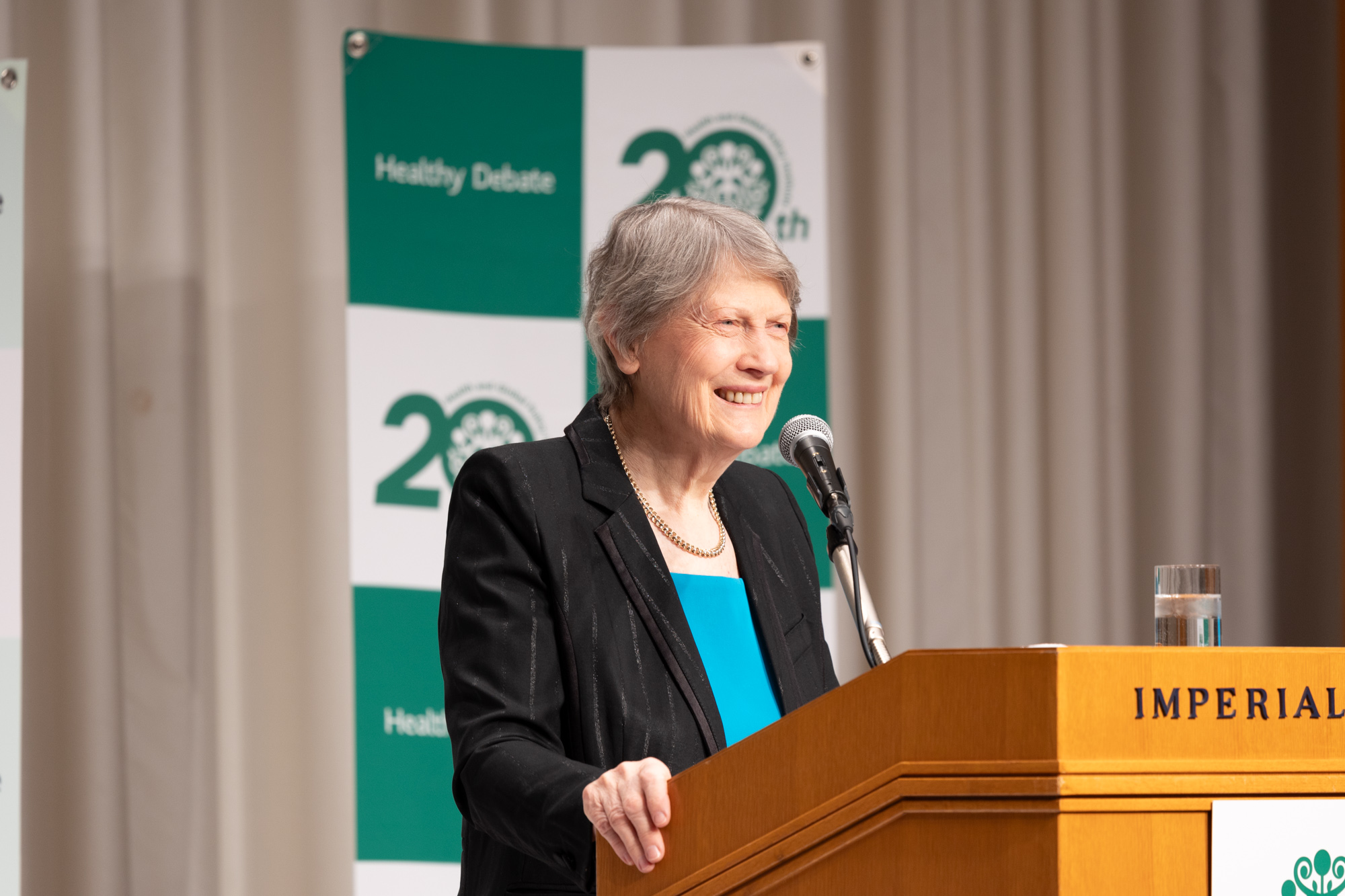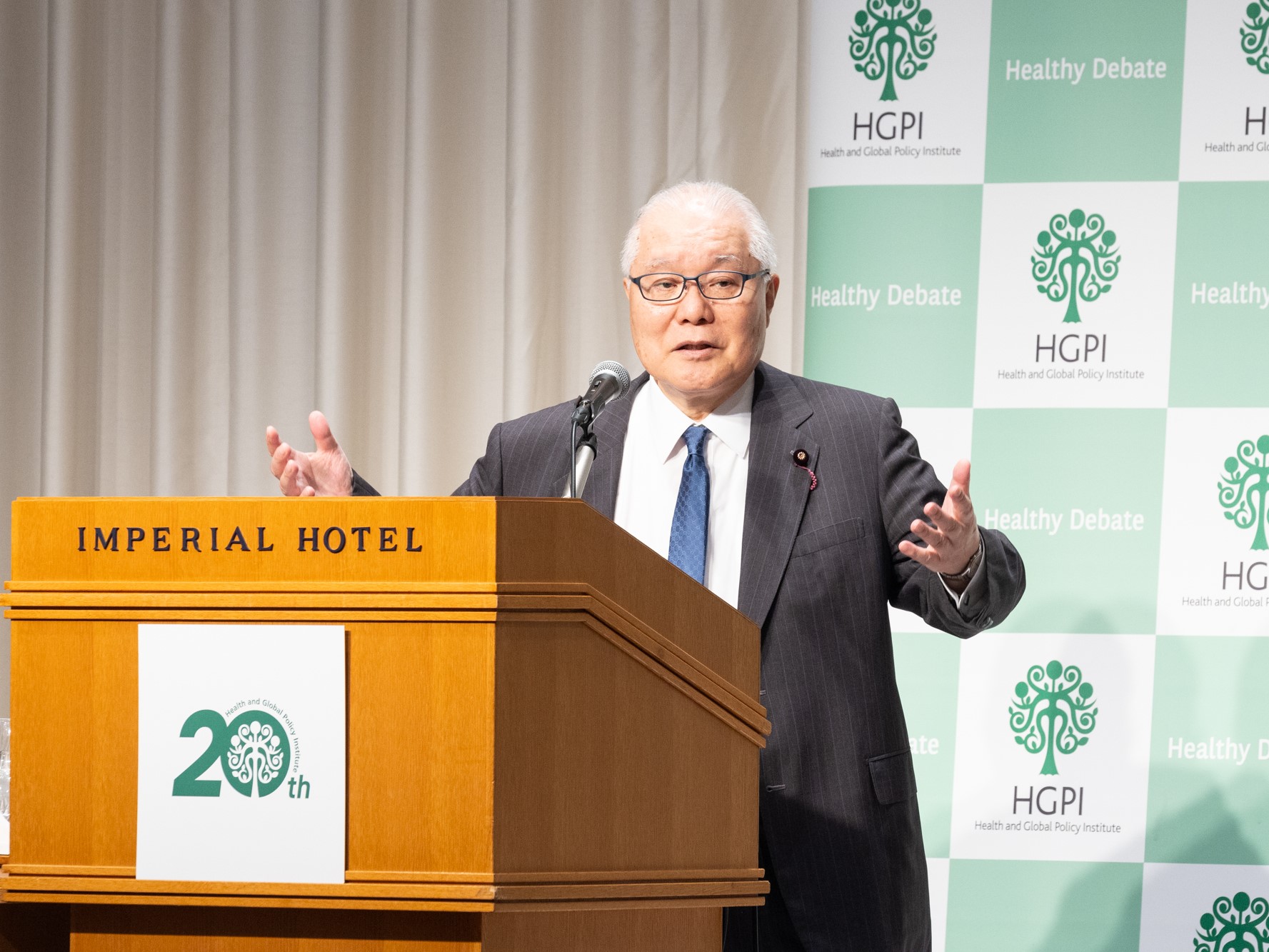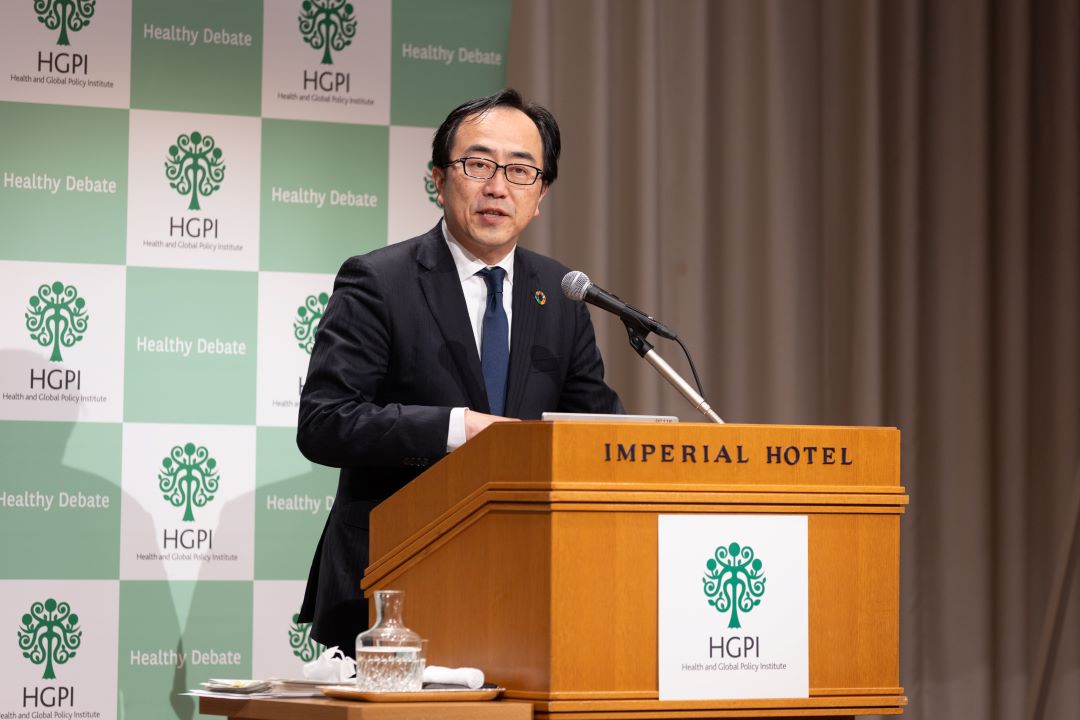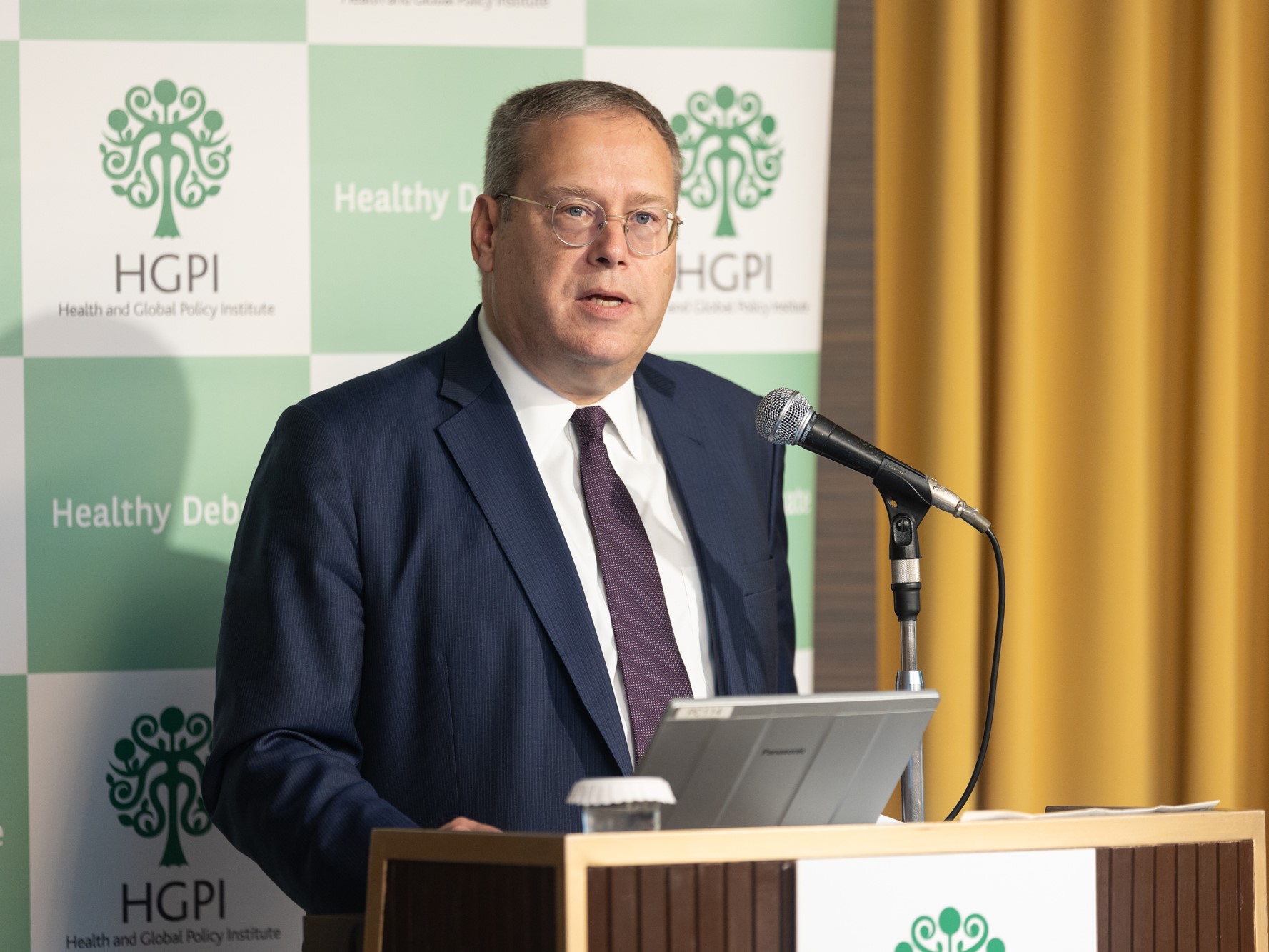[Event Report] The 57th Special Breakfast Meeting “Functional Differentiation and Collaboration in Regional Healthcare: Achieving a Reliable Medical Delivery System” (March 10, 2025)
date : 5/30/2025
![[Event Report] The 57th Special Breakfast Meeting “Functional Differentiation and Collaboration in Regional Healthcare: Achieving a Reliable Medical Delivery System” (March 10, 2025)](https://hgpi.org/en/wp-content/uploads/sites/2/0L6A9252_web.jpg)
We were honored to welcome Dr. Keiko Morimitsu, Director-General of the Health Policy Bureau at the Ministry of Health, Labour and Welfare, as our guest speaker at the 57th Special Breakfast Meeting hosted by Health and Global Policy Institute (HGPI).
In July 2024, Dr. Morimitsu became the first woman to be appointed Director-General of the Ministry of Health, Labour and Welfare (MHLW) Health Policy Bureau. In this lecture, she discussed efforts to create a healthcare provision system that ensures peace of mind for citizens through categorization and collaboration in regional health services.
<Key points of the lecture>
- As a result of efforts to foster collaboration among regional health institutions and categorize them by function under existing Regional Medical Care Visions, the number of care beds reached 1,193,000 by 2023, almost achieving the targeted number of care beds for FY2025. While there has been noteworthy and steady progress in transitioning patients with low healthcare needs to in-home care, care bed allocation remains a challenge.
- With sights set on 2040, the year that healthcare and long-term care demand is projected to peak, the MHLW has been advancing efforts to consider “New Regional Medical Care Visions.” Two key issues that require consideration are the increase in ambulance transports due to population aging and regional disparities in and greater demand for in-home care. The MHLW is examining various steps to address these issues, including establishing health systems that reflect the unique healthcare needs of senior citizens, the state of emergency transports, and the characteristics of each community. The MHLW is also reviewing how care beds are currently categorized by function.
- The uneven regional distribution of physicians is a prominent issue. This gap between regions is currently expanding, and some are concerned about physician shortages, particularly in areas with small populations. To address this, the Government has formulated the Comprehensive Package for Correcting the Uneven Distribution of Physicians and is advancing efforts with a multifaceted approach. That approach includes providing economic incentives and strengthening collaboration among healthcare institutions in communities.
■What are Regional Medical Care Visions?
The Regional Medical Care Visions initiative aims to establish systems providing efficient, high-quality, and appropriate healthcare by categorizing health institutions by function and by fostering collaboration among them while taking into account factors such as mid- to long-term demographic shifts or changes in healthcare demand in terms of quality or volume for each region. Regional Medical Care Visions were institutionalized under the 2014 Act for Securing Comprehensive Medical and Long-Term Care. They were included in the Medical Care Plan the following year.
Current Regional Medical Care Visions aim to respond to population aging and healthcare disparities among regions with a target date of 2025, when the baby boom generation will be age 75 or older. Their specific goals include categorizing care beds into four categories (the advanced acute phase, the acute phase, the convalescent phase, and the chronic phase) to estimate the number of care beds that will be necessary in 2025, and to establish high-quality healthcare provision systems that are tailored to each community by categorizing health institutions by function and building collaborative ties among them through discussions among local health professionals.
Efforts under existing Regional Medical Care Visions have advanced in accordance with the August 6, 2023 report of the National Council on Social Security Reform, which was a government expert panel for examining the future structure of Japan’s social security system established in November 2012 under the Social Security System Reform Promotion Act enacted earlier that year in August. Activities at that Council continued until August 2013. Topics covered in its discussions included responding to birthrate decline, population aging, and the widening budget deficit, as well as systemic reforms for achieving sustainability in areas like pensions, healthcare, long-term care, and birthrate measures. Its final report laid the foundation for the integrated reform of the social security and tax systems. With sights set on 2025, the year that the baby boom generation reaches age 75, the report included estimates for healthcare demand and care beds, and recommended taking action to secure health facilities and personnel to suit the categorization of care beds in a manner tailored to each region. Furthermore, recognizing that the necessary health systems would differ by community, the report also identified the need for “homegrown healthcare,” which is a concept in which each region identifies the ideal structure of healthcare and long-term care for itself.
The Government has established financial and institutional measures to support local governments’ efforts to promote medical care visions that meet their respective circumstances. For example, starting in FY2014, the Government has been providing financial support using revenue from a consumption tax increase through a framework established in each prefecture called the “Comprehensive Fund for Regional Medical and Long-term Care.” Each prefecture can form its own prefectural plan that reflects local conditions and that it can then use as the basis for healthcare- and long-term care-related projects.
■Evaluating current Regional Medical Care Visions
Estimates show that if current Regional Medical Care Visions fail to make progress in collaboration and the categorization of care beds by function, population aging will result in the need for approx. 1.52 million care beds by 2025. However, current Regional Medical Care Visions are on track to lower the number of care beds that will be necessary to approx. 1.19 million. This was accomplished through three initiatives: redistributing healthcare demand from patients in general care beds who meet C3 treatment standards or below (which denotes people who require relatively few healthcare resources) to in-home care and other forms of care; redistributing healthcare demand from 70% of Treatment Category 1 patients (who are determined to have the least need for care) in convalescent care beds to in-home care and other forms of care; and by advancing efforts to eliminate regional disparities in hospital acceptance rates for convalescent care beds.
According to the 2023 Hospital Bed Classification Report, there were 1,193,000 care beds as of 2023, which shows Regional Medical Care Visions have almost achieved their target of 1.19 million care beds. As for the breakdown, general care beds for patients graded C3 or below decreased from 118,000 to 43,000 beds (a 64% decrease); convalescent care beds for Treatment Category 1 patients decreased from 125,000 to 30,000 (a 76% decrease); and chronic care beds for patients other than for Treatment Category 1 decreased by 113,000, almost meeting the target of 119,000 beds. As we can see, there is steady progress in transitioning patients with low care needs to in-home care, but as of 2023, there were lingering challenges in the distribution of care beds for the advanced acute care, acute care, convalescent, and chronic phases. In particular, a large proportion was still being allotted to acute phase care beds, where current circumstances differ from initial estimates.
■New Regional Medical Care Visions for 2040
Background
Because the target year for the Regional Medical Care Visions initiative is 2025, in March 2024, the MHLW hosted a study group on “New Regional Medical Care Visions” with sights set on 2040. A summary of their discussions was compiled later that year in December.
It is projected that over 10 million people will be age 85 and older by 2040, which is when combined demand for healthcare and long-term care services will peak. Given this projection, in addition to hospital functions, it will be necessary for “New Regional Medical Care Visions” to take regional healthcare provision system as a whole into account, and include factors like primary care physician services, in-home care, and collaboration among healthcare and long-term care.
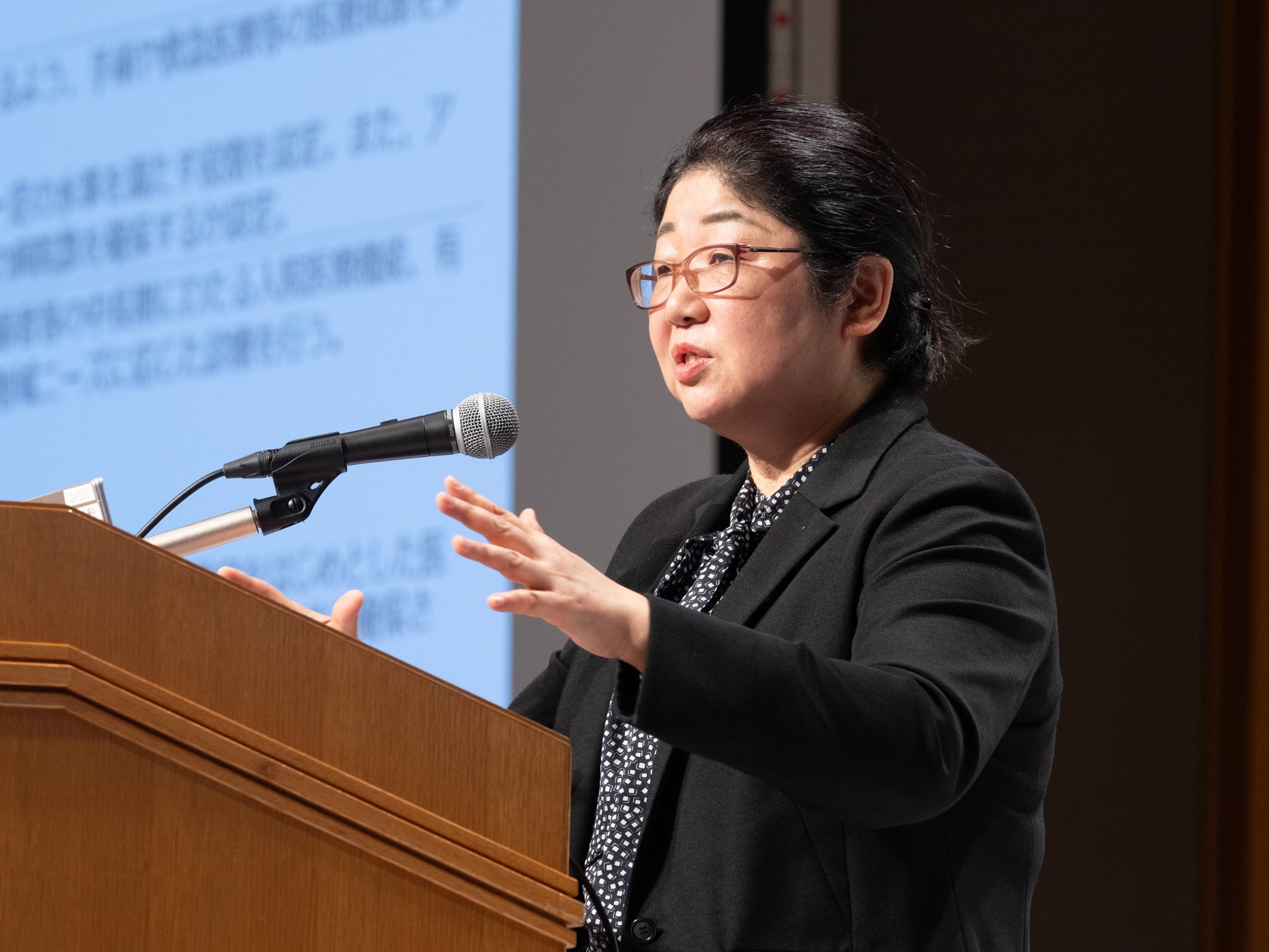
Main points for consideration
Against this backdrop, two main points should be emphasized when considering “New Regional Medical Care Visions” for 2040. First is that ambulance transports for senior citizens will increase both in number and as a share of all transports. From 2020 to 2040, the number of emergency transports is projected to increase by 36% for people age 75 and older and by 75% for people age 85 and older. Today, it is difficult for ambulances to secure hospitals to accept their patients, and this is likely to become even more difficult in the future. Focusing on the severity of those being transported by emergency services, there are significant differences in trends among those ages 15 to 64 and those age 65 and older, with one notable characteristic being that the number of senior citizens with relatively mild to moderate conditions being transported is increasing. On top of this, leading factors for acute hospitalization and necessary healthcare services are very different for senior citizens compared to other age groups. When considering how to structure the healthcare provision system of the future, senior citizens’ unique needs and circumstances surrounding emergency transport must be kept in mind.
The second main point to emphasize will be the increase in demand for and regional disparities in in-home care. From 2020 to 2040, in-home healthcare demand is projected to increase by 43% for people age 75 and older and by 62% for people age 85 and older, and meeting this demand will require rapid efforts to establish in-home care provision systems. While efforts from clinics to establish systems to provide in-home care have made progress in recent years, efforts from hospitals to develop systems to provide visiting in-home care are still behind.
Examining projections by region, by 2040, in-home care demand is expected to increase by 50% or more in 66 secondary care areas and to decrease in 23 care areas, mainly those with small populations. As this projection shows, there will be significant regional differences in in-home care demand, so developing systems that reflect local circumstances will be vital.
Reporting care bed and hospital functions
Care beds were initially arranged into four categories: the advanced acute phase, the acute phase, the convalescent phase, and the chronic phase. In FY2024, a new category of wards called “integrated community care wards” was added to the medical service fee schedule. As part of the integrated community care system, their intended use is to provide support to patients in stable condition after acute phase treatment so they can recuperate in familiar community settings. Later, in FY2024, another new category of wards called “integrated community medical wards” was added in response to an increase in emergency transports for senior citizens, particularly among people with mild or moderate conditions. These wards provide integrated support to senior citizens for speedy rehabilitation and return to the home.
However, the existing categorization of care beds was determined with disease courses for younger generations in mind, so it has been criticized as inadequate for responding to the admission and discharge patterns of senior citizens age 85 and older, or to their diverse medical needs.
In response to these and similar issues, and to accommodate the increasing number of emergency transports for senior citizens by 2040, it has been proposed that beds categorized as “convalescent care beds” be recategorized as “integrated care beds” whose function will combine a portion of acute care beds and convalescent care beds. Discussions at the Government’s study group are also examining the possibility of adding “Health Facility Classification Reports” describing the functions of each health facility alongside Hospital Bed Classification Reports in New Regional Medical Care Visions. Specifically, when arranging health facilities by function, they may be categorized by capacity for providing emergency care to senior citizens, collaboration with in-home care, capacity to serve as centers for acute care, or capacity to provide specialist health services. The aim of introducing “Health Facility Classification Reports” is to help clarify the division of roles among health facilities in each community as well as to promote collaboration, reorganization, and consolidation among health institutions.
■Addressing the uneven distribution of physicians
Background
As of FY2024, projections show that supply and demand for physicians is likely to balance out throughout Japan by 2029, but the uneven distribution of physicians among regions has been highlighted as an issue. As for the number of clinics, it is decreasing in secondary care areas with small populations and increasing in large care areas, so there is a widening gap among care areas. In addition to aging among physicians who operate clinics, those who try to open new clinics in areas with small populations are likely to encounter difficulties, so there are concerns about physician shortages becoming even more severe in such areas in the future.
Current measures to address the uneven distribution of physicians and their impact
Current efforts to address the uneven distribution of physicians generally fall under three pillars: initiatives in the physician training process; initiatives addressing individual prefectures; and work style reform for physicians. Specifically, initiatives in the physician training process aim to address uneven regional distribution by establishing regional quotas (which are quotas for the number of physicians who can practice in certain regions or departments) at university medical schools and clinical trainee quotas for each prefecture. These quotas will be determined while keeping in mind regions with few physicians. As a result of these efforts, as of 2024, approx. 9,400 physicians had been trained under the regional quota system. In addition, each prefecture has also been obligated to grasp circumstances surrounding the uneven distribution of physicians, to formulate plans for securing physicians, and to implement concrete measures based on those plans. Despite these efforts, this issue has yet to be resolved.
The Comprehensive Package for Correcting the Uneven Distribution of Physicians
To correct the uneven regional distribution of physicians, on December 25, 2024, the MHLW formulated the “Comprehensive Package of Measures for Correcting the Uneven Distribution of Physicians.” It has three basic concepts. The first concept is based on the recognition that it will not be possible to correct the uneven distribution of physicians with only a single initiative, and states, “While advancing initiatives based on plans to secure physicians, comprehensive measures will be implemented and include a combination of economic incentives, mutual support systems for health institutions in communities, and efforts taken through the physician training process.” The second is, “Taking into account aspects like physicians’ values and career paths, working and living environments, and flexible working practices, physicians of all generations including mid-career and senior physicians will be approached.” The third and final concept is, “Clearly identify which areas require support not only by considering indicators for the uneven distribution of physicians, but also by considering regional characteristics such as number of physicians per inhabitable land area or access, and implement measures that surpass conventional efforts to address the needs of remote areas.”
Under these basic concepts, the Government identified five specific initiatives to include in its Comprehensive Package for Correcting the Uneven Distribution Of Physicians (Table 1). Two areas of initiatives were discussed during this lecture. The first is ensuring that plans to secure physicians are effective. Specifically, the first step will be to identify areas where physicians are unevenly distributed that will require intensive support, and to prioritize them with focused efforts to correct the distribution. The Government is also requiring prefectures to formulate plans for correcting the uneven distribution of physicians in the areas identified. The second step will be to construct frameworks for mutual support among local health institutions. Specifically, the Government plans to expand the number of health institutions subject to the requirement for administrative staff to have experience working in areas with a small number of physicians, or similar regions. The MHLW currently has a system for recognizing physicians who have served in areas with few physicians for a certain period (six months or more) and who performed the necessary duties to provide healthcare in those areas during that period. Possessing such experience is now a requirement for administrative staff at certain health institutions. As part of the comprehensive package, in the future, health institutions that must require administrative staff to possess that experience will be expanded, and the minimum service period will be extended from six months to one year. There are also plans in place to provide physicians who want to establish new practices in areas with many outpatient physicians with requests to provide the healthcare functions needed in those areas. Specifically, in areas with many outpatient physicians, prefectures will be able to ask physicians who wish to establish new practices to submit notifications with information like the healthcare functions they plan to provide six months before opening and to participate in discussions on local outpatient care. Prefectures will also be able to request these physicians to provide the care that the region lacks.
In this manner, efforts are being made through the Comprehensive Package of Measures for Correcting the Uneven Distribution of Physicians to respond to rapid demographic changes in each region and to ensure the necessary future healthcare provision systems are in place.
(Table 1) Specific measures in the Comprehensive Package of Measures for Correcting the Uneven Distribution of Physicians
| Area of initiative | Specific content of initiative |
| 1. Ensure plans to secure physicians are effective | (1) Identify areas that require intensive support to address uneven distribution |
| (2) Formulate plans to correct the uneven distribution of physicians | |
| 2. Frameworks for mutual support among local health institutions | (1) Expand health institutions where administrative staff must have experience serving areas with few physicians, etc. and similar actions |
| (2) Submit requests to those who wish to establish new health institutions in areas with many outpatient physicians to provide healthcare functions needed in the region | |
| (3) Establish requirements for administrative staff at insured healthcare institutions | |
| 3. Economic incentives and other measures to address the uneven regional distribution of physicians | (1) Provide economic incentives |
| (2) Support the nationwide matching function | |
| (3) Support recurrent education | |
| (4) Form partnership agreements between prefectures and university hospitals and other facilities | |
| 4. Efforts taken through the physician training process | (1) Establish quotas for medical schools and regions |
| (2) Provide clinical training | |
| 5. Efforts to correct the uneven distribution of physicians among medical departments |
A lively discussion with the audience was held during the Q&A session after the lecture. Topics discussed included the possibility of reviewing secondary care areas, proposals on specific measures to address the uneven distribution of physicians (increasing regional quotas, establishing training systems for young physicians in rural areas, etc.), and implementing work style reform to enhance activities for physicians of all genders.
(Photo : Kazunori Izawa)
■Profile:
Dr. Keiko Morimitsu (Director General, Medical Affairs Bureau, Health, Labour and Welfare)
After graduating from Saga Medical University in 1992, she joined the Ministry of Health and Welfare. She served in various positions, including secondment to the Health Services Division of the Planning and Coordination Bureau of the Environment Agency, the School Health Education Division of the Physical Education Bureau of the Ministry of Education, Sports and Culture, and the Health Promotion Support Division of the Health and Medical Care Department of Saitama Prefecture, before being appointed assistant director of the Medical Care Division of the Health Insurance Bureau of the Ministry of Health, Labour and Welfare (MHLW), and director of the Research and Development Division of the Health Policy Bureau. She was appointed the first female director of the Health Care Division of the Health Insurance Bureau in 2018. In 2022, she was promoted to deputy director general for Health Care and Long term Care Integration and Data Health Reform of the Minister’s Secretariat, MHLW (concurrently serving in the Medical Policy Bureau and the Elderly Health Bureau); then director general for Crisis Management and Medical Technology, Minister’s Secretariat, MHLW in 2023 (concurrently serving in the Insurance Bureau); and in 2024, became the first female director general of the Ministry’s Health Policy Bureau.
Top Research & Recommendations Posts
- [Research Report] Perceptions, Knowledge, Actions and Perspectives of Healthcare Organizations in Japan in Relation to Climate Change and Health: A Cross-Sectional Study (November 13, 2025)
- [Research Report] The 2025 Public Opinion Survey on Healthcare in Japan (March 17, 2025)
- [Policy Recommendations] Developing a National Health and Climate Strategy for Japan (June 26, 2024)
- [Policy Recommendations] Mental Health Project: Recommendations on Three Issues in the Area of Mental Health (July 4, 2025)
- [Announcement] HGPI Endorses the “Belém Health Action Plan” (November 14, 2025)
- [Research Report] The 2023 Public Opinion Survey on Satisfaction in Healthcare in Japan and Healthcare Applications of Generative AI (January 11, 2024)
- [Publication Report] Planetary Health Promotion Project “Issues Facing Planetary Health and the Role of the Health Sector” (May 10, 2023)
- [Announcement] HGPI Joins Global Green and Healthy Hospitals (August 1, 2023)
- [Research Report] Survey of Japanese Physicians Regarding Climate Change and Health (December 3, 2023)
- [Public Comment Submission] “Interim Evaluation of the Implementation Status of the National Biodiversity Strategy 2023-2030 (Draft)” and the “7th National Report under the Convention on Biological Diversity (Draft)” (December 2, 2025)
Featured Posts
-
2025-12-11
[Event Report] Core Components of Universal Health Coverage (UHC): Achieving “Healthcare Without Financial Hardship” in Asia-Pacific and Japan (December 5, 2025)
![[Event Report] Core Components of Universal Health Coverage (UHC): Achieving “Healthcare Without Financial Hardship” in Asia-Pacific and Japan (December 5, 2025)](https://hgpi.org/en/wp-content/uploads/sites/2/HGPI_20251210_Core-Components-of-Universal-Health-CoverageUHC-top.jpg)
-
2025-12-12
[Registration Open] Meaningful Involvement Promotion Project Urgent Symposium “The New Takaichi Administration and Central Social Insurance Medical Council Reform – Ensuring Patients’ Voices are Heard” (January 22, 2026)
![[Registration Open] Meaningful Involvement Promotion Project Urgent Symposium “The New Takaichi Administration and Central Social Insurance Medical Council Reform – Ensuring Patients’ Voices are Heard” (January 22, 2026)](https://hgpi.org/en/wp-content/uploads/sites/2/HGPI_20251208_urgent-symposium-1.png)
-
2025-12-12
[Registration Open] (Webinar) The 140th HGPI Seminar “Early Detection to Reduce COPD Disease Burden: Connecting Clinical Frontiers with Health Policy” (January 27, 2026)
![[Registration Open] (Webinar) The 140th HGPI Seminar “Early Detection to Reduce COPD Disease Burden: Connecting Clinical Frontiers with Health Policy” (January 27, 2026)](https://hgpi.org/en/wp-content/uploads/sites/2/hs140-top.png)




